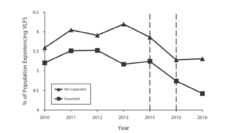Donald Trump campaigned heavily on repealing and replacing the Affordable Care Act, Barack Obama’s signature health care legislation. When repeal-and-replace failed (despite a Republican-controlled Congress for the first two years of his term), the administration switched tactics, undermining the ACA’s existence at every turn. Much of this dismantling has been aimed at the Marketplace, the collection of insurance exchanges that provide private health insurance coverage to over 20 million people.
In a particularly low blow, Trump appointees eliminated federal TV advertising for the Marketplace for the 2018 open enrollment period. They spent $0. Nothing.
Advertising for the Marketplace has been dwindling since its inception. As shown in the charts, 31% of Americans reported receiving no information about the open enrollment period in 2017, the year before the budget was cut. Paul Shafer and colleagues set out to understand the effect of television ads on Marketplace enrollment. They found that decrease in state funding for Marketplace TV ads corresponded with drops in Marketplace enrollment. Slashing the federal television advertising budget, however, did not substantially affect enrollment, indicating the Trump move was less devastating than expected. Study author, Paul Shafer, told Public Health Post, “We can’t say for sure but state ads may be more effective because people may trust their state government more than the federal government or different branding may be less likely to trigger partisan feelings.”
Publicly funded TV ads aren’t the only way that people get information about the health insurance exchanges. Government ads for insurance — including the Marketplace, Medicaid, and Medicare — accounted for just 2% of all health insurance TV ads during the 2018 enrollment period. Private insurance advertisements are associated with a jump in Marketplace enrollment. The theory is when people who plan to buy Marketplace insurance see ads for insurance, even private insurance, they’re prompted to act. The researchers speculate that better-than-expected enrollment in the 2018 open enrollment period may be due to more media attention, including news of the continuing failed legislative attempts to repeal and replace the ACA.
This research has major implications for our current moment. Shafer explained, “We are struggling through a pandemic recession, which has seen millions of Americans lose jobs and become eligible for Medicaid or financial help in the Marketplace. As the 2020 election approaches and another ACA case is pending before the Supreme Court, there is bound to be heightened confusion. If the trends we observed continue, there will be little to no advertising by state and federal governments to educate the public about their options.”
Databyte via Three in Ten Say They Haven’t Heard Anything About Open Enrollment, Nearly Half Say They Have Heard Less This Year. Kaiser Family Foundation, November 2017.














